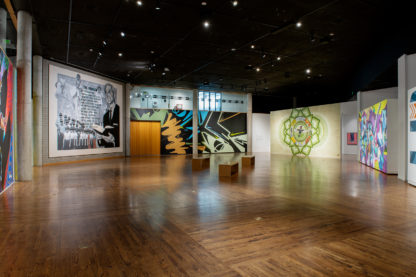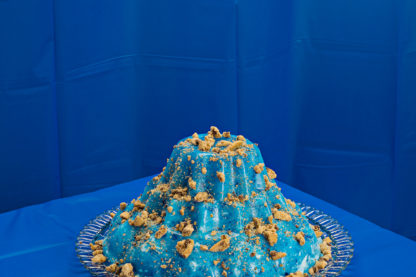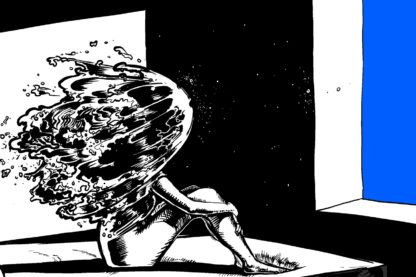The Utah Museum of Contemporary Art’s 90th anniversary year has been a splendid affair so far and exhibitions that are continuing through the early fall merit a thorough visit by patrons. This includes the seven impressive large-scale murals that signify the outstanding reputation for local public art in the street and graffiti forms. Likewise, two other exhibitions highlight the diverse excellence of the museum’s artist-in-residence program (A-I-R). There also are a charming nostalgic celebration of what a neighborhood skateboarding store might have looked like before the era of big box retail and a video directed by one of Japan’s foremost animation filmmakers.
ALL WALL: Contemporary Utah Muralists + UMOCA
The seven large murals that are on view in UMOCA’s Main Gallery through Jan. 8 confirm the full-fledged acceptance of street and graffiti art as public art in Utah. For example, later this month, the Utah Museum of Art will open 2020: From here on out, a project that invites community artists to paint original murals in the UMFA’s Great Hall. Painting directly onto the gallery walls with murals that are intended to be available for viewing for a set period accentuates both museums’ expanding acceptance of their organically dynamic institutional character.
The UMOCA murals truly capture the range of what Utah public art creators have strived to do in painting murals, which express genuine identity, culture, history, politics and critical issues of social value and empowerment. For Salt Lake City residents as well as visitors from elsewhere, ALL WALL is a wonderful visual introduction offering context to the numerous articles and rankings that emphasize the city’s diversity. Salt Lake City continues to be transformed by significant changes in its demographic composition as well as its appetite for creative entrepreneurship, which resonates with the impulses that made institutions like UMOCA in the first place.
Artists also are reckoning with the history of Utah and the American West by making incisive work that fills in critical gaps and addresses events and practices, which often have been glossed over in historiography. The mural Doo yá’át’éehii hólóo nisi ts’ídá yá’át’éeh hodooleego t’éí nitsihwiildeel, created by Denae Shanidiin and Chuck Landvatter, envelops this fundamental challenge for finding the proper depth in the historiography of telling the stories of the Intermountain West region. The largest of the seven murals, the piece magnifies the objective with piercing clarity , as it synthesizes images of children, text and, notably, the portrait of Arthur Vivian Watkins, who served in the U.S. Senate representing Utah for 12 years in the 1940s and 1950s. Watkins pressed on with efforts to eradicate all visible cultural, linguistic and formal presence of the Indigenous peoples of the U.S. For many decades, Utah, like many other states in the country, had hosted Native American boarding schools, including one of the nation’s largest, located near Brigham City — the Intermountain Indian School, which also is featured in an aerial image included in the mural. Recently, U.S. Secretary of the Interior Deb Haaland ordered a national investigation of the loss of lives, sexual and physical abuse and other devastating consequences associated with the so-called reform schools, which is scheduled to be completed in the spring of 2022. Hence, the mural shows images of the children but with black bars hiding their eyes, a sensitive consideration acknowledging that generational trauma still exists.
Each mural evokes a different tone and aesthetic. With a vibrant portrait popping in its immense size, Bill Louis, a Polynesian (Tongan/Fijian) urban abstract artist, emphasizes the visible impact of the local Polynesian community. Utah ranks among the top destinations in numbers of Tongans and Samoans living in the U.S., most notably in Salt Lake City and West Valley City. Many local art patrons also will recognize the mural created by Trent Call. Roots Art Kollective (Miguel Galaz, Alan Ochoa and Luis Novoa), a group which also is painting a mural for the UMFA’s Great Hall, produced a commanding piece for UMOCA titled Colibrí dorado. Effusive in radiant optimism, there is the hummingbird, a symbol of a new joyous day, emerging from the pandemic.
The other murals display versatile approaches to achieving masterly technique. They include the sharp lines and colors of counterpoint call and response between graffiti artist Ben Wiemeyer and tattoo artist Gailon Justus, installation artist Megan Arné’s richly textured use of color, seemingly random but purposeful in its composition, and Jessica Wiarda’s (an illustrator of Hopi/Tewa and white descent) use of negative space in a mural that also would be ideal as a graphic branding piece for the conservation movement. This project was organized by curator Jared Steffensen and was funded by the Salt Lake County’s Zoo, Arts and Parks (ZAP) program, the Dee Foundation, Zions Bank and the Diane and Sam Stewart Family Foundation.
M.M. Murdock: Welcome to the Wigglestick
Open in the Streets Gallery through Oct. 23, The Wigglestick Pretend Co. is a fabulous multidimensional installation that celebrates the nostalgia of simple childhood toys, the experience of going into a mom-and-pop-style neighborhood store and a genuine love for skateboarding long before it became a professional, commodified (and now Olympics) sport.
Created by M. M. Murdock, the pop-up store is graced with hanging skateboard decks, trucks, wheels and components, which were fashioned with upcycled materials and found objects. Curiously, some of the decks and wheels are nonfunctional. This makes senses, as young skateboarders quickly learn how to make do with limitations and this display nods to that effort. The decks are decorated with all sorts of pop cultural bits of reference. There is a definitive feel of the late Sixties and early to mid-Seventies, in the advent before mega-malls and multiplexes of theaters became the norm in so many communities. The installation rounds out the independent store vibe with a display case, an old generation cash register, a Rolodex and a rotary dial phone. There are small television screens with videos of skateboarding and there is even a ramp.
Yoriko Mizushiri: A Gentle Touch
This year, UMOCA’s Codec Gallery is featuring a trio of outstanding video art animation. The first, last spring, was a 2011 work: Mound by Allison Schulnik. Using straightforward stop-motion and claymation, she produced an entrancing five-minute video of a moving painting, crafted from more than 100 figures made from clay, wood and fabric.
The second is by Yoriko Mizushiri, one of Japan’s best-known animation film artists. The film, A Gentle Touch, compiles two of her shorter films Kamakura and Maku. Like Schulnik’s work, Miizushiri achieves compelling surrealistic effects in her hand-drawn animation with a dreamy, provocative, sensual vibe. The film’s simplicity commands the viewer to focus on the natural movements and interactions taking place on the screen. The setting is so convincingly intimate that it might inspire viewers to engage in public displays of affection in the gallery, a perfectly ideal response to Mizushiri’s video art.
Mizushiri’s latest animated short film, Anxious Body, was recently selected for screening in the Directors’ Fortnight section of the 74th Cannes Film Festival. That film follows on the techniques Mizushiri displays in A Gentle Touch. Anxious Body portrays instances where touch electrifies the body with anxiety as it attempts to respond to touches, which appear as uncomfortable or invasive. The next scheduled film in the gallery will be Erick Oh’s Opera, which was nominated this year for an Academy Award in the best animated short film category.
Daniel George: Marrow
No visit to UMOCA should be complete without checking out the A-I-R Space galleries featuring the work of the museum’s artists in residence. Barrow by Daniel George highlights the familiar mainstays of Mormon culinary traditions — the products of the Jell-O Belt. This exhibition of food porn — featuring photographs that George has taken of food he prepared by following recipes published in Mormon ward congregation cookbooks — might seem initially like a parody on stereotypes. Instead, it really appears to celebrate a nostalgic aesthetic that resists time and the ever expanding appreciation of culinary tastes and ethnic cuisines. George’s food styling compositions are appealing even among viewers who might be tempted to taste one of these dishes, if merely for satisfying curiosity.
The dishes and images could easily have appeared in a cookbook of the Sixties and Seventies. It was not just Mormon themed cookbooks at the time that had the same vibe as LDS casseroles (including funeral potatoes, a dish that even non-Mormons enjoy), quizzical takes on popular ethnic dishes, or gelatin molds and aspics containing unusual combinations of sweet and savory ingredients. A popular Twitter account originating from the U.K., 70s Dinner Party, with nearly 171,000 followers, shares many images and recipes from similar non-Mormon cookbooks.
Mormon families take pride in having well-stocked pantries and larders in their homes, where the cooking is more focused on economical resourcefulness than on highlighting the exciting adventurous experiences of trying new dishes, particularly from elsewhere. It is an exhibition about comfort food, where the practicalities of using processed food ingredients, canned vegetables and cream soups, tins of meat and fish, starches such as corn flakes and potato chips and other grocery shelf items take center stage. This was widespread, as noted above, for many families, non-Mormon and Mormon alike, during a time when a persistent recession and inflation forced many kitchen cooks to stretch their meal budgets as creatively as possible with dishes they knew others in the household would enjoy.
Jiyoun Lee-Lodge: Waterman Changing I
Located in the Exit Gallery and open through Oct. 23, an exhibition inspired by the anxieties of being isolated, displaced and disrupted during the COVID-19 pandemic, Waterman: Changing I is part of Jiyoung Lee-Lodge’s ongoing work as an UMOCA artist-in-residence. Lee-Lodge achieves an approachable, comprehensible metaphorical meditation on these emotions, where the digital screen functions as a socially distant appropriate vista for seeing the world outside during the pandemic. Thus, her works are situated in a world that many of us became glued to during long days of lockdown and social distancing where routines and work and social rhythms were upended. Viewers will appreciate the subtle inflections of Roy Lichtenstein’s technical aesthetics, blended so effectively with chiaroscuro effects and her interpretations of the stark existentialism in Edward Hopper’s Nighthawks.
The waves are a predominant element in these works, building nicely upon a metaphor that physicians, epidemiologists and world leaders have used repeatedly to talk about the pandemic. Lee-Lodge adds the proper edifying and potentially healing context. Elena Semino, a professor of linguistics and verbal art at Lancaster University in the U.K., explained the ubiquitous appeal of using metaphors such as waves in events such as a pandemic, in a July 2021 essay published in The Guardian. Semino, who has studied the application of metaphors to chronic diseases including cancer, wrote, “Metaphors are inescapable. Used sensitively and appropriately, they can help individuals and societies overcome overwhelming, long-term problems such as a global pandemic. But used insensitively or inappropriately, or when undermined by inconsistent actions and policies, metaphors can add to confusion and disillusionment, making problems harder to overcome. In short, to employ another metaphor, they can be a double-edged sword.” No doubt, Lee/-Lodge’s presentation of waves serves as a useful sign that we can take for ourselves as the pandemic begins to ebb and move off center stage.
UMOCA: Contemporary Since 1931
This is a marvelous exhibition (which closed as of Sept. 11) that brings in various artworks along with fascinating examples of historical artifacts, publications and evidence of how UMOCA’s development attracted not only the attention of Utah’s local artists but also some of the best known creators in contemporary art from national and international communities. Presented in the museum’s Street Gallery and organized by guest curator and local artist Frank McEntire and Jared Steffensen, UMOCA curator of exhibitions, the show is anchored by the meticulous research carried out by Glen Nelson and Maddie Blonquist Shrum. Exhibitions marking milestone anniversaries for institutions such as a contemporary art museum are immensely challenging because the materials are so prodigious when one considers just how broad and deep the spectrum can be defined for what contemporary art means.
Furthermore, UMOCA’s history has matured through three significant periods, starting with the Art Barn in 1931, and then becoming the Salt Lake Art Center in 1959 and, finally, its present UMOCA designation in the last ten years. One of the clearest representations of this evolution comes through the display of the museum’s logos covering the 90 years of its existence. And, most recently, the museum updated its logo, signaling the museum’s commitment to capture evolving practices of contemporary art, particularly those represented in the five other exhibitions that coincide with this celebration.
Outsiders might be surprised to think that a museum dedicated to contemporary art in Utah has thrived and has enjoyed such a healthy longevity, particularly as its founding came during the Great Depression. But, UMOCA’s resilience also is due in part to the state’s pioneering reputation for affirming art education and literacy. Take, for example, Alice Merrill Horne, one of the greatest champions of local and public art in Utah’s history, who had a passion especially for the output of artists who lived and worked in the state. In 1899, Horne, at 30, had just been elected to the Utah Legislature and she quickly embarked on a politically ambitious agenda, particularly on the behalf of public education and on ensuring access to all of the essential amenities and benefits for all schools and children, regardless of their families’ means. Among the items was creating the nation’s first state-sponsored art agency. This ensured public access to art for all Utah residents, which included amassing 37 collections of Utah art in public schools. Certainly, one can appreciate why Utah embraced the mission that became UMOCA. One of the most pleasant surprises of this exhibition is the number of the world’s best known artists who exhibited work in Utah. They have included Diego Rivera, László Moholy-Nagy, Marc Chagall, Wassily Kandinsky, Andy Warhol and Robert Rauschenberg ,among others.
UMOCA continues its 90th anniversary celebration on Saturday, Sept. 18, with a free family art Saturday birthday bash, from 1 to 4 p.m. in the outdoor courtyard of the museum (20 S. West Temple).








2 thoughts on “Utah Museum of Contemporary Art continues 90th anniversary celebrations with exhibitions including murals by local street, graffiti artists; Yoriko Mizushiri animation; works inspired by Mormon culinary traditions, pandemic”